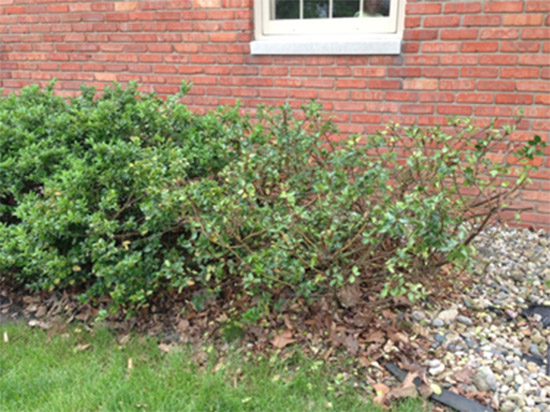Issue 8, June 14, 2013
Holly Decline: Fully Utilizing U of I Extension Resources and the Plant Clinic
As a plant diagnostician, I have quickly learned that there are several different types of homeowner mindsets when it comes to diagnosing and managing their landscape problems. There are some plant problems that can be diagnosed over the phone or via a picture and the U of I Plant Clinic is not needed. However, there are complicated plant issues that do not have an easy diagnosis.
I recently solved a problem for a person that moved into a new home and she was consistently having problems with the holly bushes planted in her front landscaping. She had done research, contacted her local Extension, and then was referred to the U of I Plant Clinic. She submitted several branches that appeared to be yellowing and declining. Unfortunately, the sample only consisted of symptoms and not the plant pathogen clues needed for diagnosis. I suspected the problem was at the base of the plant or below ground. This meant that the Plant Clinic needed a resample(s), pictures, or a site visit to determine if there were fungal cankers involved, injury at the base, improper planting, or root rot.
A site visit confirmed that the holly bushes were declining, as seen in the picture below.

At first glance, I noticed that these bushes did have cankered branches. The branches were taken back to the Plant Clinic lab and were found to be infected with Botryosphaeria. This fungus usually infects plants that have been stressed by environmental factors (flooding, drought, freeze/thaw, etc.), site problems (compaction, competition, nutrient imbalance, etc.), or injuries (before or after planting). Infection occurs through wounds. Symptoms usually begin as lesions on the twigs and gradually spread throughout the tree. Cankers (dark sunken areas) will form on infected branches; and vascular tissue beneath the cankers is killed. These cankers may girdle the branches, causing wilting and loss of leaves. We really didn’t stop our inspection there, because fungal cankers often signal further stress involved.
Further investigation was done by digging out the mulch/dirt around the base of the plants to check for signs of improper planting.

As you can see in the picture, when looking at the base of the bush, the lower branches were practically underground, I suspected that these bushes had been planted too deeply and this could cause a gradual decline of the bushes over time. In order to determine if your tree/shrub is planted too deep, you will need to locate the first major root coming off the trunk. It should be at or just below the soil line. A flare of the trunk should be visible above the soil line. The trunk should not be the same width at the soil line as it is 4' up the trunk. It is really a pretty simple concept: roots are below ground and everything else is above the ground. There is not much you can do if an established shrub is found to be planted too deep. You can try to pull back the soil from the base of the shrub.
Most would stop there and be satisfied with a fungal canker and deep planting diagnosis, but there were other red flags that indicated further problems with the roots. This area had been irrigated and holly is susceptible to root rot pathogens, such as Phytophthora root rot. The roots of this holly were submitted to the U of I Plant Clinic and tested positive for Phytophthora using an Agdia immuno quick strip. Some things that can contribute to Phytophthora infection include:
- Compacted or poorly drained soil
- Planting too deep or over mulching
- Water standing in the area for several hours
- One of the shrubs could have been infected when purchased
Phytophthora control in the landscape is mostly comprised of sanitation and good cultural practices. There are fungicides available as a preventative measure, but are mostly used in nurseries and rarely in the landscape. A few things you can do to prevent and manage this disease include:
- Choosing hollies adapted to the local climate
- Purchasing hollies with healthy white roots
- Planting on a raised bed with other shallow rooted shrubs
- Amending beds with pine or hardwood bark
- Fertilizing to maintain vigor
Unfortunately with Phytophthora, there is no way to stop the infection once it has started and these shrubs will mostly likely die. However, included in the link below is a fact sheet on Phytophthora that includes recommendations on what to plant in a site with a history of this disease: http://www.cals.ncsu.edu/plantpath/activities/societies/ornamental/AG-747_Crown%20Rot.pdf
In conclusion, thanks to the research done by this homeowner, the guidance of the U of I Extension, and the utilization of the U of I Plant Clinic, we were able to use a team approach to get to the “root” of this holly problem.
Author:
Stephanie Porter